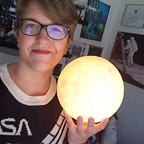Artemis, Explained
What is the Artemis?
A Return to the Moon Launches Later This Year
Daughter of Zeus and twin sister of Apollo, Artemis is known for her strength. NASA chose this ancient Greek name for their new lunar landing program, launching this year.
A Return to the Moon
In 2019, then NASA Administrator Jim Bridenstine announced plans to return to and sustainably explore the Moon. With that comes the first woman and first person of color to the lunar surface and preparations to send astronauts to Mars. Five years later, we have reach a major milestone for this goal.
Now Premiering: Artemis I
The much-anticipated Space Launch System (SLS) will be the most powerful rocket in the world upon lift-off, slated to bring both astronauts and cargo to the lunar surface in the future.
This vehicle test is a full dress rehearsal of real space conditions for the rocket— our generation’s version of early Saturn V testing. No facility on Earth can recreate the real conditions of space that the SLS vehicle will experience. The Orion heat shield remains untested in real space conditions, a vital piece of hardware that ensures the astronaut’s safe return.
“Our primary objectives essentially conclude that we complete the mission as planned in order to get to reentry where we will test the heat shield and recover the spacecraft,” outlined Mike Sarafin, the Artemis Mission Manager at NASA HQ, during a press conference during July 2022.
At the time of writing this, the first two launch dates were scrubbed and the space agency is now preparing for a launch date in October. The launch can be watched via NASA TV.
The Mission
This inaugural mission starts at launch pad 39B at the NASA Kennedy Space Center. With 8.8 million pounds of thrust, the SLS will blast off the pad. From that moment, NASA has started recording vital flight data.
Overtime pieces will fall back to Earth. First, the boosters. Then the fairings. When the crowd at Canaveral can no longer see any inkling of the rocket (about 8 minutes into the event), the main engine will cut off an detach.
Orion is then on its way to lunar orbit. Orion will deploy its solar arrays, which provides electricity and additional propulsion. Course correction occur as needed to ensure the arrival to lunar orbit. Engineers on Earth will evaluate spacecraft systems.
Around a week later, at a precise moment, the Orion engines will fire for a short burn. The capsule will escape the moon’s gravity while still allowing it to propel the capsule back to earth. Similar to when a pitcher winds up before releasing the baseball.
Upon returning to Earth, Orion will enter the atmosphere travelling at 25,000 mph. The heat shield reaches temperatures of 5,000 degrees Fahrenheit in some spots. The atmosphere itself will slow the spacecraft to 300 mph, then three parachutes deploy to slow Orion further. When the craft hits the Pacific Ocean off the coast of San Diego, it’s falling at less than 20 mph.
Orion and the parachutes will be recovered. The mission is complete. The hardware is then returned to NASA, where data will be analyzed.
